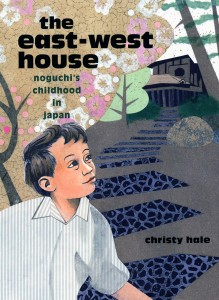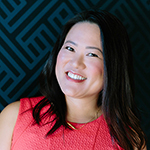What better way to kick off the HapaMama Summer Reading Series than the lovely and aptly titled picture book, The East-West House: Noguchi’s Childhood in Japan (Lee and Low Books), by Christy Hale.
 The book tells the story of sculptor Isamu Noguchi. Noguchi was the son of a Scotch-Irish American mother, Leonie Gilmour, and a Japanese father, Yonejiro Noguchi. The story takes place in an earlier era. At the start of the book, it is 1907, when Gilmour moves with her young son to Japan, so the boy can be near his father. Soon, they realize the older Noguchi has another wife and family in Japan. (The story is handled very subtly.) Although the tale takes place a hundred years ago, many of the themes are still very relevant. Leonie and Isamu face discrimination, and the other schoolkids have a hard time comprehending Isamu’s mixed racial and cultural heritage.
The book tells the story of sculptor Isamu Noguchi. Noguchi was the son of a Scotch-Irish American mother, Leonie Gilmour, and a Japanese father, Yonejiro Noguchi. The story takes place in an earlier era. At the start of the book, it is 1907, when Gilmour moves with her young son to Japan, so the boy can be near his father. Soon, they realize the older Noguchi has another wife and family in Japan. (The story is handled very subtly.) Although the tale takes place a hundred years ago, many of the themes are still very relevant. Leonie and Isamu face discrimination, and the other schoolkids have a hard time comprehending Isamu’s mixed racial and cultural heritage.
Isamu finds solace in art and nature, and at age eight, draws up plans for a very unique house for he and his mother:
“Half eastern, half Western in design,
it was a mixture like his own.”
I had the opportunity to interview Hale about how she came about the story of Isamu Noguchi.
HapaMama: How did you decide to write this story about Noguchi?
Hale: I have worked for Lee & Low Books (multicultural children’s book publisher) since their inception, art directing, designing, and illustrating many picture books. In 2002, then publisher, Philip Lee, mentioned that he wished he had a picture book about the biracial 20th century sculptor/designer, Isamu Noguchi. His comment was not an invitation to me, but I jumped on the opportunity anyway for three main reasons: first, I have wanted to wear the author’s hat since I was ten; second, I’m keenly interested in artists and have introduced children to many throughout my career as an art instructor, as well as through writing the “Masterpiece-of-the-Month” feature for Scholastic’s Instructor Magazine; and third, in my own family there are two branches with Asian/Caucasian children.
I was somewhat familiar with Noguchi’s work, but did not know his personal story. I plunged into research and soon it became clear that this mercurial artist’s life and legacy would not fit easily into a 32-page picture book format. I looked for a nugget to become my focus. The more I read about the artist, the more the struggles of his early life resonated and seemed to set the theme for his whole life. Isamu Noguchi was born in 1904 to a Japanese father and Scotch-Irish American mother. His mother brought Isamu to Japan when he was two, but his father and mother were not married, and his father had taken another Japanese family. Isamu’s father was not present in his life, and Isamu did not fit in to the society around him. With guidance from his mother, Isamu found solace for his loneliness and non-belonging as he explored the natural world and worked with his hands. When Isamu was only eight, his mother gave him the opportunity to meld his dual heritage in the design and building of a new home in Chigasaki. The house combined eastern and western architectural elements. The East-West House: Noguchi’s Childhood in Japan tells this story.
I think Noguchi is an unsung hero. Someone who never felt he belonged to any place, devoted his art to creating spaces for others to share.
HapaMama: What kind of feedback have you received from readers, particularly mixed-race readers?
Hale: Promoting my book has allowed me chances to speak with children and adults. In every context—schools, libraries, bookstores, museums, Oban celebrations, Japanese crafts fairs, book festivals, and more—I’m amazed by how many people approach me and tell me that they or someone in their family is biracial. Kids are sympathetic with young Isamu. They are familiar with bullying and understand how loneliness led Isamu to find happiness, apart from others, in his art. Some people I meet already are fans of Noguchi’s work, but many don’t know the breadth of his achievements. Most have not heard of his childhood accomplishments. Kids love that he got to build a house when he was only eight! Everyone is drawn in by Noguchi’s personal story and happy that there is a book showcasing a mixed-race character.
Incidentally, there is a big Noguchi show opening this month at the Laguna Beach Art Museum. A trip to the museum would be a great follow up to reading this book. I will be doing a family program there on Sunday, July 17th at 1.p.m.
HapaMama: Tell me a little about the style of artwork you used to illustrate this book…
Hale: I worked in mixed-media collage. Isamu loved nature so I wanted to evoke earth, water, wood, and stone. He grew up to become a sculptor so it seemed important that the book be very tactile. I printed the rough wood grain of my back steps to simulate Japanese wood block prints. I recycled patterned business envelope liners to simulate Japanese textiles. I made my own stamps from gum erasers. I tore paper for soft edges, cut for crisp edges. Watch the Youtube interview about the making of this book and see more about my process:
These stories are for everyone. Kids of all shapes, sizes, and colors should be able to find themselves pictured in books. It’s also important that kids learn that others, all over the globe, though the specifics of their situations may be different, are still basically the same at heart. We need to celebrate both our uniqueness and our similarities.
You can learn more about Christy Hale and her books at her website, and remember to check back to HapaMama every Thursday this summer for more Summer Reading picks for Hapa families!
[Disclosure: A review copy of The East-West House was provided by Lee and Low Books]


Great interview, it’s always so inspiring to see books published that have a biracial/bicultural topic. Very few out there.
Exactly! I have been trying to find books with bicultural themes for my kids and running into that very same dilemma of not finding that many, especially for younger kids. That’s why I decided to compile this Summer Reading series so we can share ideas. If you have any suggestions, please contact me to pass them on!
Such an enlightening interview. And yes, what kid would not LOVE knowing and being inspired by a child who built his own house when he was eight. Thanks for bringing this fascinating, gentle, brilliant artist to life, Christy!